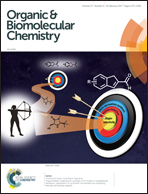Revisiting secondary interactions in neighboring group participation, exemplified by reactivity changes of iminylium intermediates†
Abstract
Neighboring group participation is defined as the action of a substituent to stabilize a transition state or an intermediate by forming a bond or a partial bond with the reaction center. In addition to the primary interaction with the nearest neighboring group, secondary interactions involving another neighboring group(s) could also occur in principle. Here, we revisit this issue by examining the influence of secondary interactions on the stability and reactivity of the putative iminylium cation intermediates, formed by N–O bond cleavage of 1-tetralone oxime systems. A direct observation of a peri-bromo-iminylium intermediate in solution supported the involvement of iminylium cations and the stabilizing effect of secondary interactions arising from a distal tandem substituent. Both experimental and computational findings support the idea that secondary interactions of a tandem-neighboring group on the primary peri-heteroatom (Br, Cl, and O(Me))-iminylium bonding interaction, i.e., a weak halogen bonding interaction (ester (nitro) oxygen–halogen bonding) and an unprecedented hydrogen bonding interaction between a nitro oxygen atom and a CH3O hydrogen atom, are crucial determinants of the reaction pathway, leading to either overwhelmingly selective syn-migration of the oxime functionality or covalent bond formation under acid-catalyzed Beckmann rearrangement conditions.



 Please wait while we load your content...
Please wait while we load your content...